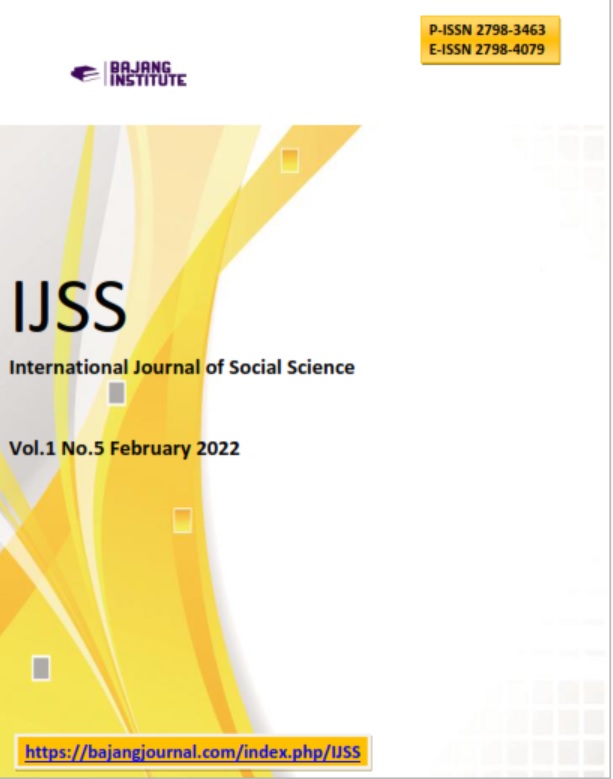THE EXISTENCE OF TEJAKULA WAYANG WONG DANCE DRAMA, A CULTURAL HERITAGE FOR PRESERVATION, DELAMINATION, AND TOURISM ATTRACTION
DOI:
https://doi.org/10.53625/ijss.v1i5.1304Keywords:
Dance Drama,Wayang Wong, Tejakula, Cultural Heritage.Abstract
The various extent of publications by Tejakula Wayang Wong (literally Human Wayang) indicates the conservation efforts of art observers who jointly maintain this tremendous cultural heritage conforming to their respective capacities.Pengempon residents perform this art performance as sincere and earnest offerings to the Almighty for the abundance of His Blessings. In Bali, there are types of Wayang Wong, e.g., Wayang Wong Parwa and Wayang Wong Ramayana. The Wayang Wong Parwato the play from the epic Mahabharata, while Wayang Wong Ramayana took the play from the epic Ramayana. The emergence of the Wayang Wong dance-drama in Bali is estimated when Balinese artistic life experienced its peak of glory during the reign of Dalem Watu Renggong. It is estimated that artists such as I Dewa Batan from Bunutin Village (Bangli) brought the Parwa dance around the XVII- XVIII centuries, and I Gusti Ngurah Made Jelantik from Blahbatuh Village (Gianyar) brought the Gambuh Dance.These two artists create Wayang Wong's performance art in Tejakula Village.
How can this Wayang Wong drama dance still exist and even become a tourism attraction? What are the residents doing to maintain this cultural heritage?These questions become the trigger to find out the answers through interviews, watching live performances, and literature studies to find references as supporting data for this article.
Community participation in the owners is the main determining factor for the sustainability of this Wayang Wong dance drama. The district and provincial governments' customs, attention, and motivationtrigger the growth of new awareness for the millennial generation to love their own culture.People's dedication is very high and no doubt because their offerings are not measured financially, but the satisfaction for being able to pray and their own pride because their family witnesses it, children, wives, grandchildren and even very possibly by their own parents. Wayang Wong is regarded as intangible cultural heritage is the correct and precise act to appreciate and motivate its sustainability.
References
Ardika, I Gede. 2004. Pengembangan dan Pemberdayaan Kebudayaan Dalam Konteks Kepariwisataan (Mencermati Seni Pertunjukan II, Perspektif Pariwisata, Lingkungan, dan Kajian Seni Pertunjukan; Editor; Santosa), kerjasama Ford Foundation & Program Pascasarjana STSI Surakarta.
Bandem, I Made. 2001. Wayang Wong, Bali Mangsi Press. Yogya. Akademi Seni Tari Indonesia Denpasar.
Bandem, I Made., Fredrik Eugene deBoer. 2004. Kaja dan Kelod Tarian Bali dalam Transisi, Institut Seni Jogjakarta,
Dibia, I Wayan, 2002. Nilai-nilai Estetika Hindu dalam Kesenian Bali (Estetika Hindu dan Pembangunan Bali; penyunting I B G Yudha Triguna), Program Magister Ilmu Agama dan Kebudayaan UNHI-Widyadarma, Denpasar.
Dibia, I Wayan, 2012. Geliat Seni Pertujukan Bali, Widya Pataka, Bali.
Dibia, I Wayan, 2012. TAKSU Dalam Seni Dan Kehidupan Bali, Bali Mangsi, Denpasar.
Kayam, Umar. 1981. Seni, Tradisi, Masyarakat, Sinar Harapan, Jakarta.
Ruastiti, Ni Made, I Komang Sudirga, I Gede Yudarta, 2019. Education Values in Wayang Wong Innovative Arts ‘Cupu Manik Astagina’, Journal of Arts & Humanities, Volume 08, Issue 09, DOI: http://dx.doi.org/10.18533/journal.v8i9.1732.
Ruastiti, Ni Made., I Komang Sudirga, I Gede Yudarta, 2020.The Wayang Wong Millennial Performance Art Model as a New Tourist Attraction in Bali, International Journal of Innovation, Creativity and Change. www.ijicc.net Volume 14, Issue 5, 2020.
Soedarsono, 1990. Wayang Wong, The State Ritual Dance Drama In The Court Of Yogyakarta, Gadjah Mada University Press, Yogyakarta.
Sumandiyo Hadi, Y. 2007. Sosiologi Tari Sebuah Pengenalan Awal, Pustaka, Yogyakarta.
Widyastutieningrum, Sri Rochana. 2018. Reviving Wayang Orang Sriwedari in Surakarta: Tourism-Oriented Performance, Asian Theatre Journal, Vol. 35, No. 1 (spring 2018), by University of Hawaii Press.

















